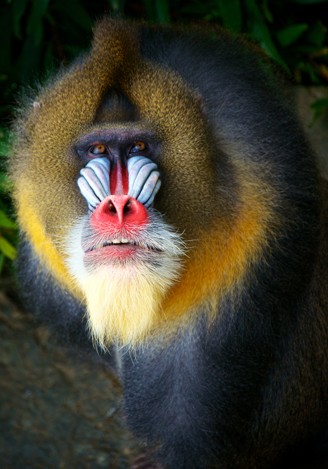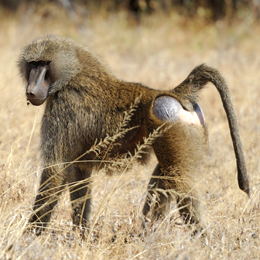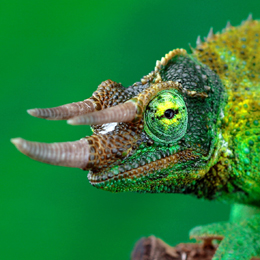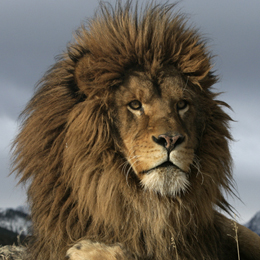Description
Many people mistake mandrills for baboons as they look similar. But this is far from the truth. Baboons and mandrills belong to a completely different genus. In fact, mandrills were once classified as baboons. Advanced studies show that there were too many differences between the two animals to put them in the same class.
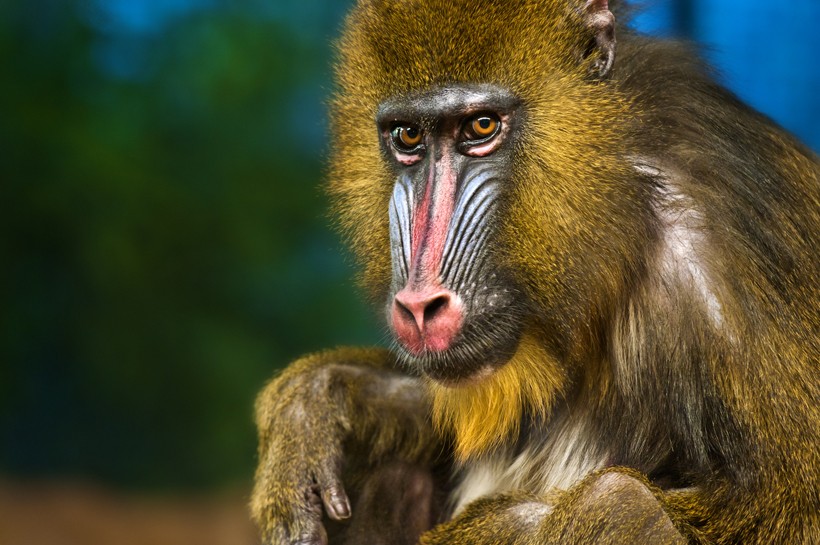
Male mandrills have vivid colors that make them stand out from the rest of the primates.
?
Image credits: Kris Wiktor/Shutterstock
They are also called the forest baboons, and the reason is pretty evident! You guessed it - they live in the forests, and they look like baboons. These wonderful primates belong, like golden snub-nosed monkeys, to the Old World monkeys and are believed to be the largest species of monkeys in the world. They are also one of the most colorful creatures that inhabit the tropical rainforests of Africa.
Members of the genus Mandrillus are large primates that are hard to miss. They grow to a height of 55-95 cm (22-37 in) with an average weight of 10-37 kg (22-82 lbs). Sexual dimorphism in mandrills is one of the greatest found among primates. Adult male mandrills are about 75-95 cm (30-37 in) long and weigh about 19–37 kg (42–82 lbs). Larger males weighing about 54 kg (119 lbs) have also been spotted. Female mandrills are smaller than their male counterparts. Adult females are around 55–66 cm (22–26 in) and weight around 10–15 kg (22–33 lbs). Their short tails add 5-10 cm (2-4 in) more to their stature.
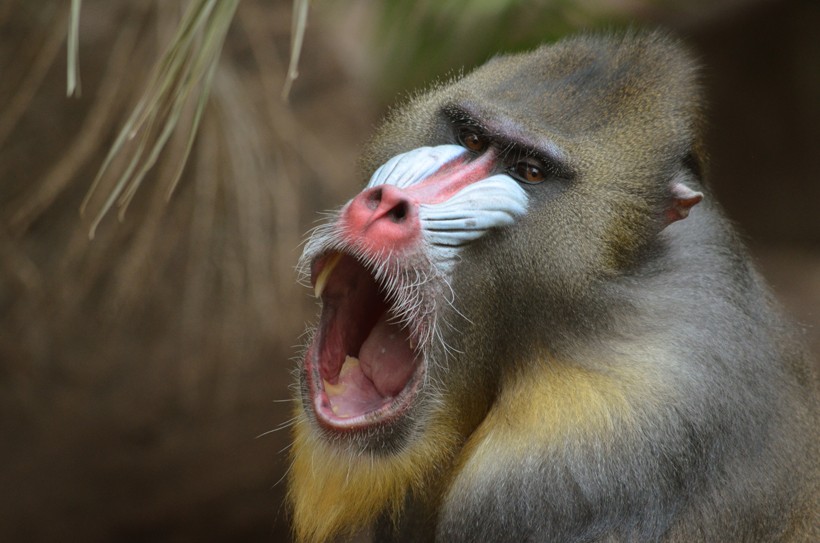
Male mandrills have 4,5 cm long canines
?
Image credits: Susan Flashman/Shutterstock
In addition to the size, males and females have more differences in their appearance. Male mandrills have vivid colors that make them stand out from the rest of the primates. Females have far more subdued coloration than the males. Longer canines of about 4.5 cm (1.8 in) are observed in males contrary to the smaller ones of about 1.0 cm in females.
Mandrills are known to live up to an age of 20-31 years in wild and over 40 years of age in captivity. Studies show that under semi-free conditions, male mandrills lived up to 41 years of age, and females outlived them with an age of 25 years. Their sense of sight, hearing and smell are highly evolved. Forward-pointing eyes help them better judge the distance while in the trees.
Mandrill vs. Baboon
Contrary to the popular belief, mandrills are not related to baboons. However, both animals resemble each other and people often get them wrong. Where the similarities in their appearance end, the dissimilarities start. The natural habitat of mandrills is restricted to Africa, whereas baboons are found in Africa and Arabia. Baboons have 5 different species (olive, chacma, yellow, Guinea and hamadryas). On the other hand, mandrills do not have any subspecies.
The most striking difference between mandrills and baboons is the colorful face. Mandrills have blue and red skin on their faces. Contrary, baboons are not so dramatic-looking primates. The tails of baboons are long and resemble that of a dog. Mandrills have short, stocky tails. These tails are supporting them to keep an upright position.
Anatomy and Characteristics
This is what Charles Darwin had said about mandrills:
“No other member in the whole class of mammals is colored in so extraordinary a manner as the adult male mandrills”
The olive-brown coats of mandrills have irregular patterns and the underparts are pale. Male mandrills have a stunning blue or purple naked rump. The rump in females and juveniles is dull and not as gorgeous. Males have a bright red nose and lips with blue ridges on both sides of the nose. The rear end and genitalia of males are also of the same color. White whiskers, red patches above the eyes, a dark brown crest on the crown, and a yellow beard complete the look, making mandrills stunningly colorful.
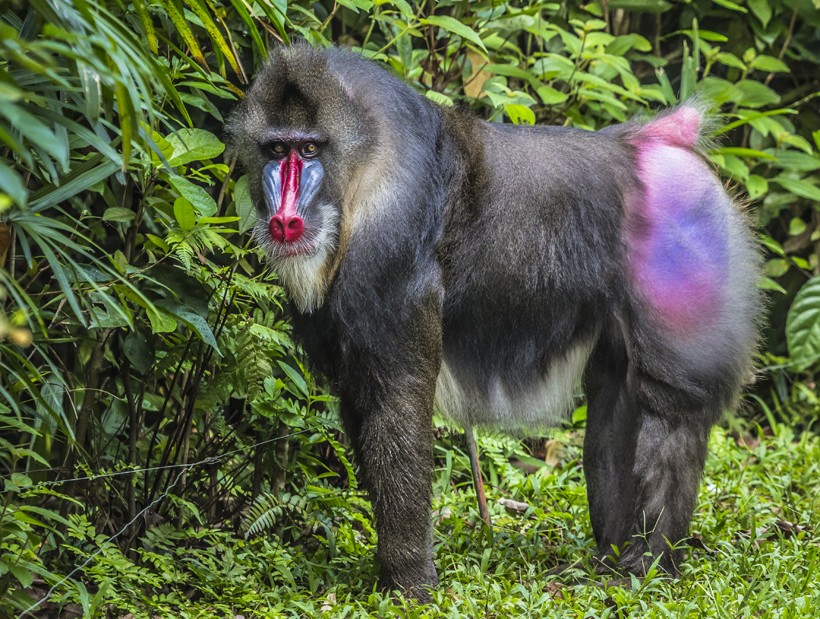
Male mandrills have a stunning blue or purple naked rump.
?
Image credits: Curioso/Shutterstock
Mandrills have powerful, stocky bodies with strong, muscular arms. Their massive heads appear too large when compared to their bodies. Both the sexes have short, stubby vestigial tails. The eyes are small and sunken and mandrills have prominent brow ridges. The scent glands on the chest are used for scent markings, a rare phenomenon among the Old World monkeys. They have extremely long canine teeth (about 5 cm) that might look intimidating. The canines are used for self-defense. However, flashing the teeth can also be a friendly gesture.
Mandrills have their own built-in containers to carry food and store it. Their cheeks are large and have pouches in the mouth. They carry goodies in the pouch to enjoy them at leisure. Opposable thumbs help the primates to securely grasp the branches of the trees. They walk in such a fashion that their palms and soles do not touch the ground, using only their fingers and toes for the movement.
Habitat
Mandrillus sphinx are found in tropical rainforests including lowland moist forest, lowland rain forest and other primary and secondary rain forests. Mandrills have also been spotted in the savannah mosaic forests. They prefer habitats with very dense vegetation and thick bushes. It has been observed that mandrills migrate to different grass areas within their forest habitats. The western central African countries Gabin, Nigeria, Equatorial Guinea, southern Cameron and Congo are homes to mandrills.
The large primates are terrestrial as well as arboreal. They spend both time on the ground as in trees. Mandrills typically sleep in the trees at night. They can go high up the tree all the way to the canopy to find food.
Diet
Mandrills are omnivores and have a varied diet that includes herbs, seeds, tubers, shoots, fungi, fruit, and roots. They also eat worms, spiders, ants, snails, small bugs, and lizards. Typically, male mandrills search for food that can be found on the ground. For females and juveniles, the search for food takes place on midlevel trees. The mischievous monkeys are believed to have raided plantations and crops.
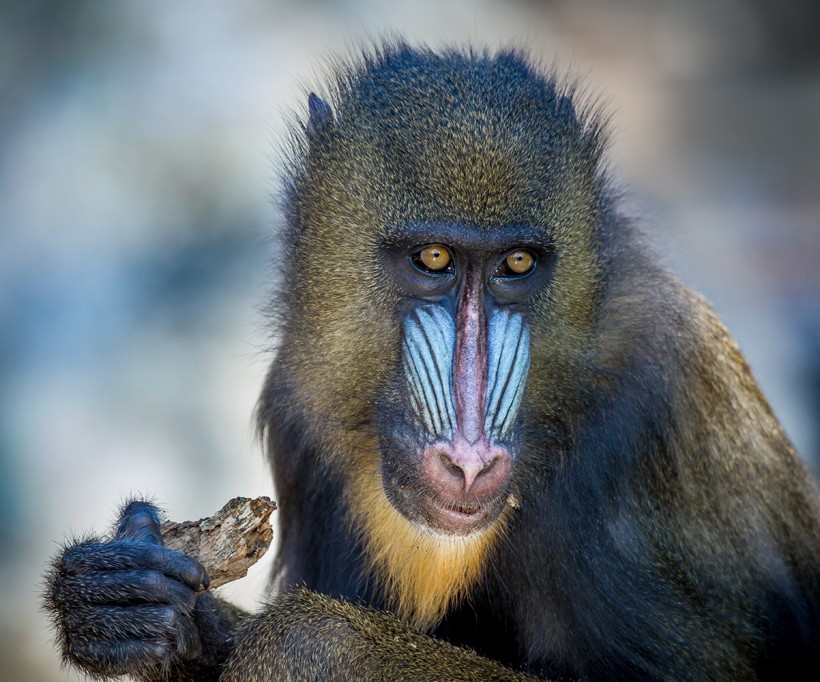
The diet of the omnivorous Mandrill contains worms, spiders, ants, snails, small bugs, and lizards.
?
Image credits: jo Crebbin/Shutterstock
They have a big appetite and are known to eat anything they can get their hands on. It has been observed that under extreme conditions, mandrills may eat eggs or even the offspring of other monkey species. They may also eat small antelopes when there is a shortage of their usual food.
In the natural environment, mandrills have only a few predators because of their large size. However, animals such as leopards, hawk-eagles and snakes may prey upon them, especially on young mandrills.
Reproduction and Life Cycle
The mating system among mandrills is polygamous. The dominant male of the harem protects all the females in the troop and enjoys exclusive mating rights with the females in the harem. When females are in estrus, the male of the harem randomly mates with them and fathers an offspring.
During the estrus, the sex organs in females swell, indicating that the female is ready to mate. The alpha males have increased testicular volume, the genitalia and face become bright red and there's an increased secretion of the sternal cutaneous gland. Once alpha males lose their dominance, they become paler. There is no set mating for mandrills. Some studies show that males fight to win the mating rights.
Breeding among mandrills is not seasonal but depends upon the food supply. It occurs once in every two years, typically between July and October. The birthing occurs between December and April.
Female mandrills attain sexual maturity at 4-5 years of age and give birth to their first offspring between 4-8 years of age. For males, the age for sexual maturity is around 9 years. The bachelor mandrills must assert themselves, find their own food and fight with other males to climb on the ladder of hierarchy. During this period of struggle, males develop a brightly colored face and rump. The surge of testosterone makes the colors more vibrant, making the males more attractive to females.
The gestation period is about 167-175 days (6-7 months) where the female give birth to a single infant. Infants weigh on average one or two pounds at birth. They have a pinkish face, dark fur coat and white hair on legs and arms. The newborns hair transforms into an adult coat in about 2 months.
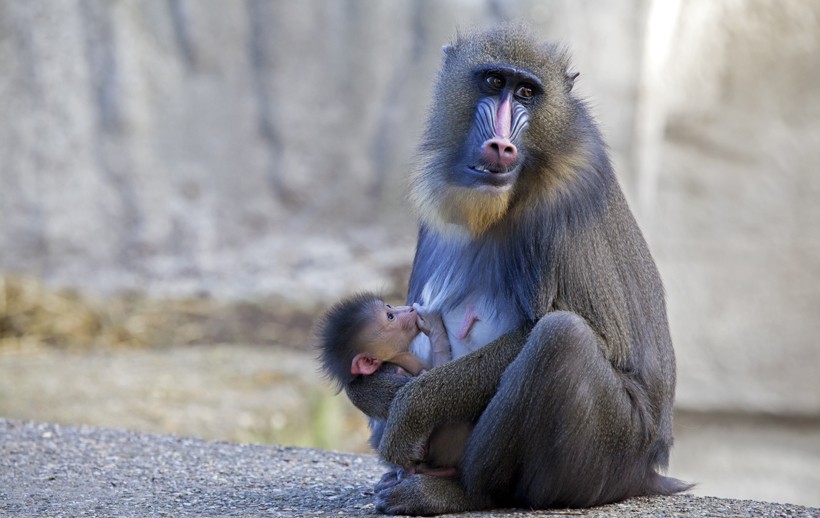
Mother mandrill weaning her newborn
?
Image credits: Edwin Butter/Shutterstock
Mothers are excited to welcome their offspring and do not mate again until the juvenile becomes an adult. If the offspring dies, they mate again to fill the void. Young mandrills attach themselves to the mothers' bellies as soon as they are born. When they become too heavy, they travel on the mothers' back.
Parental care is the responsibility of mothers. Mothers provide nourishment, protection and grooming. As they live in a group, aunts, sisters and cousins may also help in the rearing of the young mandrills. Females other than the mother may carry, play with or groom the young. In some cases, males have also been observed to provide parental care in the form of carrying, grooming and playing with the offspring.
Weaning occurs until 6-12 months. Young female mandrills don't leave the group and stay with the troop they were born into. Mothers and daughters share a very strong bond that remains intact for life. Young male mandrills leave the troop around the age of 6 years and stay alone. However, they have been believed to forage with the group.
Behavior, Communication and Intelligence
Mandrills are highly social animals and socializing is a vital part of their lifestyle. Socializing is carried out in the form of grooming, playing and chatting. They live in stable troops. Such troop may range from a few individuals up to 100 individuals. Larger troops of 615 and 800 individuals have also been observed. The troops typically have a territory of about 50 square km (19,3 mi2). Mandrills mark their territories with their scent and defend it from predators.
Male mandrills live a solitary life and enter a group only when the females are ready for mating. The leader of the troop is a dominant alpha male with the boldest and brightest colors. The dominant male may drift away from the troop but returns when there is any threat.
Male mandrills protect the harem from predators and intruders. They growl and display their teeth to scare off the intruders. If this doesn't work, they jump up and down and then turn into violence.
Mandrills stay on the ground the largest part of the day and climb up the trees for the night. They tend to select a different tree each night. The bright colors of the mandrill is a striking feature. Once the monkey gets excited, the chest turns blue, the blue color of their rear end intensifies, and red dots may appear on the wrists. The bright rump flashing is a signal of receptiveness and submissiveness.
Male mandrills shake their heads and shoulders to exhibit playfulness. This is a form of invitation to be groomed. To display friendliness, mandrills expose their teeth and slightly lift their lips.
Angry mandrills may violently slap the ground. Staring at the intruder and scratching thighs or forearms is also a sign of anger.
When mandrills are not able to perform a desired activity, they may yawn. The act of yawning is also interpreted as a response to a threat. Under such circumstances, mandrills spread their arms, lower their heads and flash their sharp teeth.
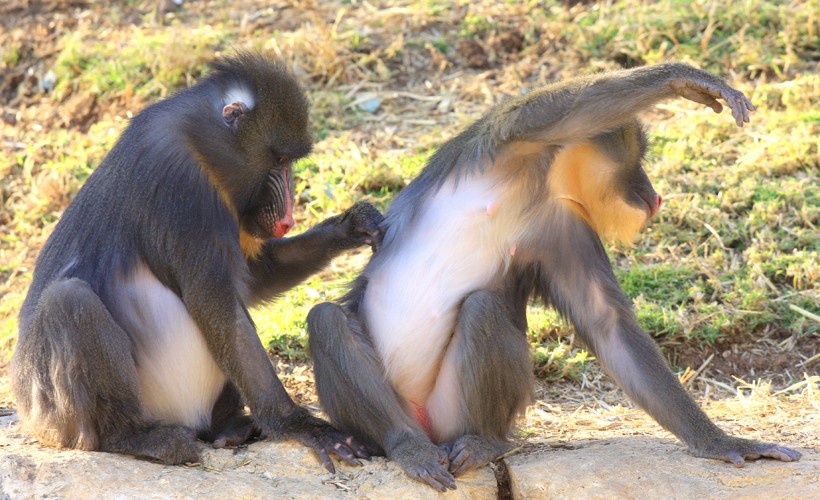
Mandrill apes delousing eachother
?
Image credits: Amihays/Shutterstock
Grooming is an important part of their daily activity. It may be accompanied by smacking noises. The communications among mandrills are through grunting when they are in the wild. There are also other ways of communication such as tactile, visual, acoustic signals and scents.
Tactile communication is in the form of grooming when individuals lift each other’s furs with their tongue, fingers, and lips. Adult males groom estrus females and females return the favor.
Visual communication is performed by males when they open their mouth and reveal their teeth. This form of communication is used when they sense a threat. Silent bared teeth gestures are used as a friendly communication.
Mandrills have a variety of sounds for vocal communication.- Roar is for group movement and is used only by males.
- Grunt is a threatening call used by all members of the troop.
- Crow is to coordinate the aggression.
- Growl is heard during mild alarm situations.
- Scream is a call for escape or fear.
- Grind is heard during tense situations.
- Smack is used during copulation and grooming.
Olfactory communication is through sternal gland markings. Individuals rub their sternal glands against each other. This is also the way mandrills mark their sleeping sites. Dominant males and estrus females use olfactory communication more than the other members of the troops.
In Colchester Zoo, Essex, a 15-year old female mandrill was studied. It was observed that every time the mandrill covered the face with hands, it meant "Leave me alone". The female mandrill had invented a new gesture for communication. Over a period of time, other fellow young mandrills had also picked up the gesture. This mimicking each other's actions show that mandrills are intelligent primates.
Population and Conservation Status
The exact population size of mandrills is not known. However, studies show that there has been a drastic decline in population. They are considered as a vulnerable species and are listed under this category by the International Union for Conservation of Nature (IUCN).
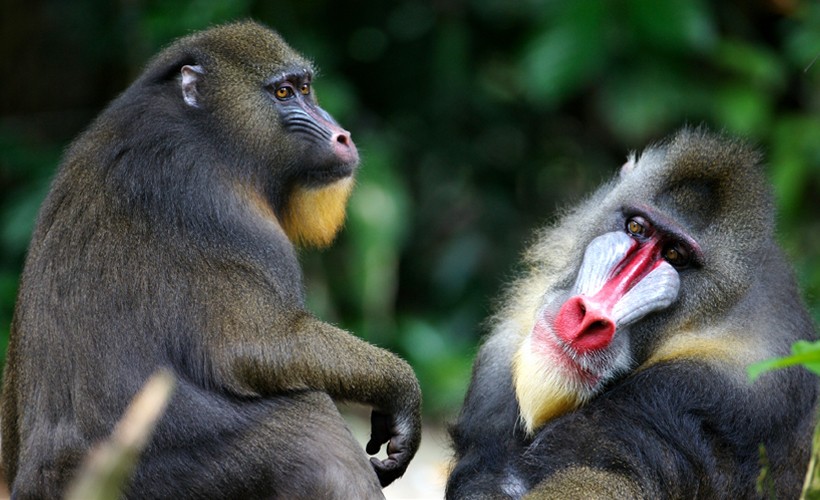
The mandrill is listed as a vulnerable species by the International Union for Conservation of Nature (IUCN).
?
Image credits: Kitch Bain/Shutterstock
The natural habitats of mandrills are being destroyed, leaving these amazing creatures homeless. Besides deforestation, mandrills are hunted for their meat. They are easily spotted by hunters because of their loud cry. The illegal logging and bushmeat trade, if not controlled, can threaten seriously the population of mandrills. Cameroon government is working with the conservation organizations to establish a national park to maintain mandrill habitat and check on illegal logging and bushmeat trade.
Evolutionary History
Unfortunately, limited information is available regarding the evolution of Mandrillus, the genus to which mandrills belong. Very few primate fossils have been discovered in western Central Africa. Further studies should give a better understanding of the evolutionary history of mandrills.
Funfacts
- Mandrills are the largest species of monkeys.
- Thanks to their forward pointing eyes they have binocular vision.
- The hands of mandrills are extremely skillful. They use their hands to collect and sort food.
- The term "mandrill" means "man-ape".
- Mandrills are considered as pests as they destroy crops.
- Moods of mandrills can be identified with their gestures.
- Only the dominant male with brighter colors can bring up an offspring, in contrast to the subordinate male with pale colors.
